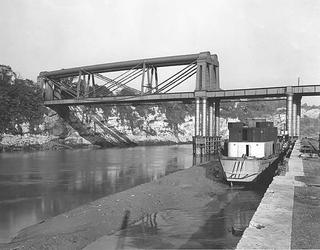
Chester & Holyhead Railway boundary stone
- Made:
- 1845-1859 in unknown place
- maker:
- Chester & Holyhead Railway
Boundary marker, stone, Chester & Holyhead Railway, about 1845 to 1859.
Boundary marker, Chester & Holyhead Railway, dating from about 1845 to 1859. Boundary markers like this were used to clearly identify the limits of railway land and to distinguish them from adjacent property. They were typically used where it was difficult to install a fence or hedge, where there was a risk of encroachment by other landowners, or where there had been a dispute over land ownership. They also delineated one railway company’s territory from another’s, for instance to make it clear who was responsible for maintaining a particular stretch of line.
The Chester & Holyhead Railway was authorised by an Act of Parliament passed in July 1844. It was built to connect the port of Holyhead on the island of Anglesey (Ynys Môn) in north Wales with Chester and, by other railways, to London. Ferry services across the Irish Sea linked Holyhead to Dublin in Ireland and the railway was used to convey mail, government dispatches, passengers and goods. The London & North Western Railway, which helped to finance the building of the line, absorbed the Chester & Holyhead Railway in 1859.
This boundary marker is a piece of dressed stone with the company initials, “C & H R W Co” inscribed in two lines of Roman lettering on its face. Much of the stone would have been buried to make it difficult for it to be dug up and removed.
Details
- Category:
- Railway Infrastructure
- Object Number:
- 1998-9505
- Materials:
- stone
- Measurements:
-
overall: 1130 mm x 410 mm x 180 mm,
- type:
- boundary marker
- credit:
- British Rail, Clapham




